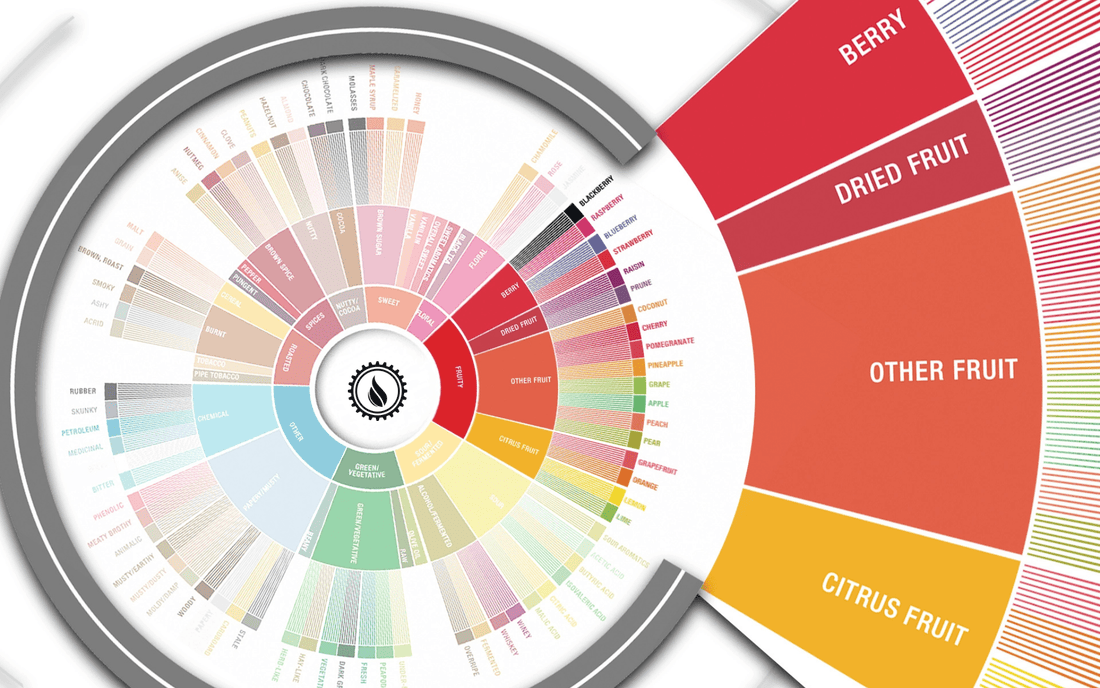
Deep Dive: Fruity Flavors in Coffee
Fruity flavors are among the most vibrant and varied descriptors on the coffee flavor wheel. Because coffee beans are seeds of a fruit, certain coffees express clear berry, citrus, stone fruit or dried fruit notes. The Specialty Coffee Association’s flavor wheel breaks these into sub‑categories like berry, dried fruit, other fruit and citrus fruit. Learning to identify these descriptors can make tasting single origin coffee more rewarding.
Why some coffees taste fruity
Fruity notes arise from the bean’s genetics and processing. The origin and terroir—soil composition, climate and altitude—strongly influence flavor. Ethiopian coffees are famous for their fruity and floral notes, while certain Central American beans lean toward apple or pear. Processing methods matter: natural (dry) processed beans dry inside the coffee cherry and absorb fruit sugars, enhancing berry‑like sweetness. Washed processing yields cleaner, more acidic profiles, while honey processing strikes a balance.
Roast level also affects fruit expression. Lighter roasts preserve the bean’s inherent fruity compounds; darker roasts can obscure them. Many ethically sourced coffee farms and direct trade coffee programs emphasize proper processing to showcase these notes.
Exploring the fruity sub‑categories
- Berry: Notes like raspberry, blueberry and strawberry are often linked to Ethiopian and Kenyan coffees. These high‑acidity beans are popular among craft coffee roasters seeking vibrant profiles.
- Dried fruit: Flavors such as raisin, prune and date are common in coffees from Yemen and parts of Central America. They suggest deeper sweetness and can appear in medium roasts.
- Other fruit: Apple, grape, peach, pear and cherry notes vary widely with origin. For example, Guatemalan beans may exhibit green apple, while Colombian beans lean toward red grape flavors.
- Citrus fruit: Lemon, lime, orange and grapefruit contribute brightness and acidity. High‑altitude coffees, such as those from Ethiopia’s Yirgacheffe region, often display these vibrant notes.
How to identify fruity flavors
Before tasting, smell the fragrance of ground coffee—fruity notes often appear in the aroma. Take a sip and let it linger on your tongue; consider whether the acidity reminds you of green apple or the sweetness evokes ripe berries. Comparing different coffees side by side can help highlight subtle differences. Use the flavor wheel as a visual guide. Brewing methods also matter: pour‑over techniques like Chemex or V60 emphasize clarity and brightness, bringing fruity notes forward.
For the adventurous palate
If you crave fruit‑forward cups, look for small batch coffee roasters who specialize in naturally processed beans and light roasts. A coffee subscription box focused on single origin coffee can introduce you to a range of berry and citrus profiles.
For a full overview of how the wheel structures these flavors, revisit our complete Coffee Taster’s Flavor Wheel piece. And if you want to taste coffees with incredible fruitiness, check out our offerings at Steel Oak Coffee.
